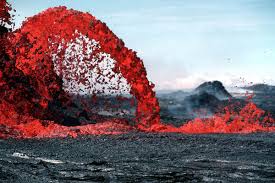
The largest ever volcanic eruption under the sea was detected by scientists from the University of Tasmania with the use of submersible vehicles that successfully mapped the remote location of the eruption.
A satellite detected solidified volcanic rock, known as pumice raft, was detected under the sea which was over 400 square kilometers in 2012 which drew the attention of scientists, which was the second time that the volcano - the Havre Volcano, came into the limelight for the second time in history. The volcano is located about 1,000 km off the North Island of New Zealand and was first discovered in 2002.
"When this rock was produced by the volcano, it rose through the water column onto the sea surfaced and then it was dispersed by wind and sea currents," University of Tasmania volcanologist and lead author of the study, Dr Rebecca Carey, said.
"We knew it was a large scale eruption, approximately equivalent to the biggest eruption we've seen on land in the 20th Century."
Two submersible vehicles were sent to the remote location by scientists who collaborated with a team of researchers and international collaborators.
"We used an autonomous submarine to make high resolution topographic maps of the sea floor," Carey said.
"We did about 12 different surveys for 8-12 hours each and those maps are so high resolution that we were then able to use a remotely operated vehicle which is tethered to the ship, to actually go down and make observation of the eruption and also bring back samples."
Scientists believe that it is important to learn about volcanoes under the sea because over 80 percent of the volcanoes in the world are located underwater.
"Volcanoes provide heat and chemicals to the ocean and that input is actually really important when it comes to sustaining life," Carey said.
"Havre is a cornerstone eruptive event because for the first time we are able to constrain exactly what happened, where it happened, at what depth, how much and how fast it erupted."
"With this sort of quantitative understanding, we are able to probe the fundamental questions about how submarine volcanoes work."
“The eruption rate of the raft was equivalent to large, on-land explosive eruptions, which is astounding," study co-author Samuel Mitchell, a PhD student of volcanology at the University of Hawai’I at Mãnoa, told IFLScience.
"What’s really cool is that the Havre eruption erupted lava from 14 different vents aligned on caldera ring structures that together represent a massive 6-8 kilometer (3.7-5 mile) long rupture of the caldera wall," said Carey
(Source:www.xinhuanet.com & www.iflscience.com)
A satellite detected solidified volcanic rock, known as pumice raft, was detected under the sea which was over 400 square kilometers in 2012 which drew the attention of scientists, which was the second time that the volcano - the Havre Volcano, came into the limelight for the second time in history. The volcano is located about 1,000 km off the North Island of New Zealand and was first discovered in 2002.
"When this rock was produced by the volcano, it rose through the water column onto the sea surfaced and then it was dispersed by wind and sea currents," University of Tasmania volcanologist and lead author of the study, Dr Rebecca Carey, said.
"We knew it was a large scale eruption, approximately equivalent to the biggest eruption we've seen on land in the 20th Century."
Two submersible vehicles were sent to the remote location by scientists who collaborated with a team of researchers and international collaborators.
"We used an autonomous submarine to make high resolution topographic maps of the sea floor," Carey said.
"We did about 12 different surveys for 8-12 hours each and those maps are so high resolution that we were then able to use a remotely operated vehicle which is tethered to the ship, to actually go down and make observation of the eruption and also bring back samples."
Scientists believe that it is important to learn about volcanoes under the sea because over 80 percent of the volcanoes in the world are located underwater.
"Volcanoes provide heat and chemicals to the ocean and that input is actually really important when it comes to sustaining life," Carey said.
"Havre is a cornerstone eruptive event because for the first time we are able to constrain exactly what happened, where it happened, at what depth, how much and how fast it erupted."
"With this sort of quantitative understanding, we are able to probe the fundamental questions about how submarine volcanoes work."
“The eruption rate of the raft was equivalent to large, on-land explosive eruptions, which is astounding," study co-author Samuel Mitchell, a PhD student of volcanology at the University of Hawai’I at Mãnoa, told IFLScience.
"What’s really cool is that the Havre eruption erupted lava from 14 different vents aligned on caldera ring structures that together represent a massive 6-8 kilometer (3.7-5 mile) long rupture of the caldera wall," said Carey
(Source:www.xinhuanet.com & www.iflscience.com)





